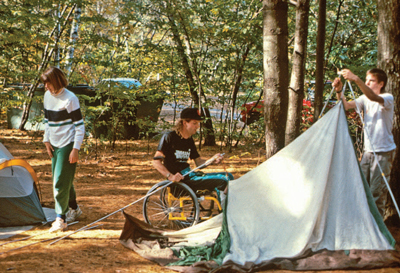Why Accessibility Is Important
The Forest Service is committed to integrating and maximizing accessibility into the full range of recreation opportunities while protecting natural resources and maintaining the character and experience of the settings so that all people have the opportunity to enjoy the great outdoors. This commitment is established in Forest Service policy.
How does accessibility fit into this range of opportunities? We certainly don't want to pave the wilderness. However, when the decision is made to construct or alter a building, trail, recreation site, or other facility, we must ask, "How can we design, purchase, or build it to ensure all people have an equal opportunity to use this facility?" The key is to ask this question before the facility has been designed and built or purchased. Then we can provide facilities for use by all people.
For more information on Forest Service recreation opportunities, visit http://www.fs.fed.us/recreation/.
How many people benefit from accessible facilities? At the time of the 2010 census, 54 million people (about 1 in every 5 people in the United States) had a disability that significantly limited one or more major life activities, such as walking, seeing, hearing, breathing, and thinking. Of that number, 7 percent used wheelchairs, and 2.1 percent used crutches, canes, walkers, or other assistive devices. Seventy-five percent have disabilities that are not obvious at first glance. People with disabilities constitute the largest minority in the country.
Additionally, the population of the United States is aging. By the year 2030, more than 80 million people will be 65 or older. As people age, impairments are more likely to hinder activities. If you live long enough, you are likely to join the ranks of people with disabilities.
Recreation Opportunities on National Forests and Grasslands
There are national forest and grasslands in all but six of the States and in Puerto Rico and the Virgin Islands.
-
155 national forests and grasslands
-
193 million acres (78.1 million hectares) to enjoy
-
-
439 congressionally designated wilderness areas
-
37.6 million acres (15.2 million hectares) in which to experience solitude and a pristine environment
-
-
156,000 miles (251,000 kilometers) of trails to hike
-
122 wild and scenic rivers
-
4,927 miles (7,929 kilometers) of beautiful water to float or fish
-
-
19,611 recreation sites and 23,000 recreation buildings
-
5,000 campgrounds in which to pitch a tent or set up a trailer or recreational vehicle
-
-
Thousands of miles (or kilometers) of scenic byways to drive
-
172 million visits each year
If anyone in a group has a disability, accessibility is an issue for the whole group (figure 1.) This influences where the group will go and what they will do together. Ski areas learned many years ago that each skier who has a disability is usually accompanied by three or four additional skiers who don't have disabilities. They all want to buy lift tickets, rent gear, eat lunch, and ski together. Accessibility is good customer service and good for business.

Figure 1—Although the Blackberry Crossing Campground in the White Mountain National Forest is not highly developed, it's a great place for this group of friends to enjoy camping together. Photo credit: Northeast Passage, Durham, NH
Just as recreational preferences vary among the general population, people with disabilities enjoy different types of outdoor recreation. We must make sure that facilities allow all visitors to choose their own recreational activities.

User Comments/Questions
Add Comment/Question